Hands-On With The Huawei P50 Pro: The 2022 Flagship with a Snapdragon 888 Option
by Dr. Ian Cutress on February 9, 2022 11:00 AM EST- Posted in
- Smartphones
- Qualcomm
- 4G
- Huawei
- Leica
- Snapdragon 888
- P50
- P50 Pro
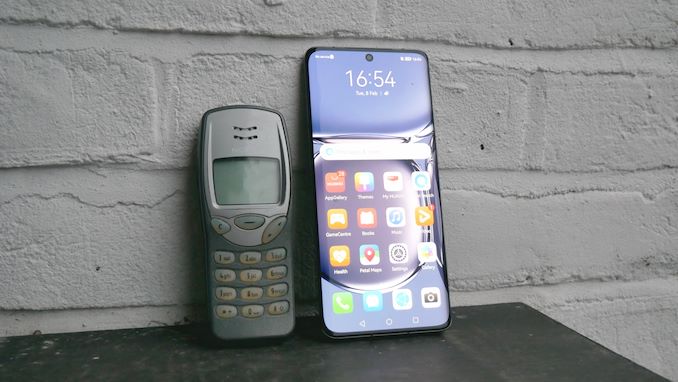
For those of us outside the US, Huawei has maintained its presence in a number of markets in which it has grown its sales over the last decade. Even without access to Google Services or TSMC, the company has been producing hardware and smartphones as it pivots to a new strategy. To lead off in 2022, that strategy starts with the Huawei P50 Pro, the next generation of flagship photography camera. The P series from Huawei has often been the lead device for new cameras and new features to attract creators, and the model we have today is a new twist in the Huawei story: our model comes with a Qualcomm flagship Snapdragon chip inside.
Perspective: Huawei and Hardware
For anyone outside the US, it’s not hard to notice that the noise around Huawei’s smartphone efforts has been dulled since it was put on the US entity list in May 2019. At that point the company was readying devices with the Kirin 990 chip on 7nm, and was in development of the next generation hardware on 5nm. Over the course of the next 12 months, knowing that it would be losing access to TSMC and Google services, various pivots had to be made to ensure that the smartphone business stayed solvent. The company had to take its final orders of smartphone silicon it had at TSMC through to mid-2020, and then try and implement its own path without access to leading edge manufacturing.
For flagship smartphones, the Huawei P40, launched in April 2020, used the Kirin 990 5G hardware. In late 2020, after the final orders of chips were delivered, Huawei launched the Mate 40 Pro with the Kirin 9000, built on TSMC’s 5nm process. Huawei was a lead partner alongside Apple at TSMC on 5nm, and as a result the company built a stockpile of silicon not knowing when (or if) it would get access back. Questions were raised if Huawei had enough stock of Kirin 9000 chips to last the lifecycle of the Mate 40 Pro.
Through 2021 however, the company did not launch a flagship smartphone outside of China. Normally we see Huawei alternate with every six months we would get a P-series focusing on camera, or a Mate series focusing on internals and everything else. But in 2021, we didn’t get either. Without building its in-house silicon, one of Huawei’s key value-adds it had for its ecosystem was lost, and that included optimizations with in-house AI designs of which part of its software was based.
Cue 2022, and at the start of this year, Huawei has launched the P50 Pro and P50 Pocket outside of China. The P50 Pro is a different beast, as it comes in two versions, much like the Samsung Galaxy Ultra: Huawei offers the P50 Pro with either the same Kirin 9000 as the previous Mate 40 in China and select markets, or with Qualcomm’s 2021 flagship SoC, the Snapdragon S888, everywhere else. Due to the economics (and perhaps stock levels of Kirin), Huawei has come to an agreement with Qualcomm to buy top silicon for its top smartphone.
Users will be quick to point out that the S888 in the P50 Pro is last year’s Qualcomm flagship SoC. Qualcomm recently announced the 2022 Snapdragon 8 Gen 1, which is set to be the lead chipset in a lot of smartphone brands, with devices launching very soon (Mobile World Congress is in a couple of weeks). The question as to why Huawei went with S888 rather than S8g1 is more of logistics – Huawei is finding a new cycle and needs to get to grips with where it will put flagships in future. The Kirin 9000/S888 is likely a better similar performance comparison than K9000 vs S8g1, so in order to keep all models equivalent, that’s how it had to go. Also, Huawei is likely organizing contracts for future smartphones which are purely Qualcomm (or purely MediaTek), and there’s a cycle that goes to that. The P50 Pro was simply too early in that cycle, but also helps Huawei sort the other business issues out.
Ideally with a device that offers two different chips inside, we’d love the opportunity to compare both, however we only have the S888 version to test today. As perhaps one of the last S888 flagships, it will be interesting to see how Huawei has combined its design aesthetic (which is usually really good) with an opportunity to learn from a year’s worth of S888 flagships.
Hands-on with the Huawei P50 Pro
One thing that has impressed me over the years with Huawei devices is simply the refinement of the design ID. Since the P8 came to market, I’ve noted that Huawei’s efforts in design have been towards just making the device look good and fit well. Sometimes that has come with a splash of color, such as the Pantone models, but also similarly the understated models still stood out as premium.
The only thing that really bothered me is that despite the looks, the inability for a device to stay still on a table without having a case due to the glass back had meant that using that clear plastic case that comes with the phone is a must. As a result, it sometimes dulls that multi-colored visual, as it did with the P30 Pro, or in this case with the Golden Black P50 Pro I have, makes it look cheap. It also means that despite the 6.6-inch screen being crammed into a svelte chassis with near zero bezel, a plastic case adds volume.
The screen is a 6.6-inch OLED, with the wrap-around visual that we’re used to on devices this size, but it’s not actually wrap-around. This means you can actually hold the edges, and mistouches are far less frequent. Huawei does this with a very slight curve that is noticeable on the screen, but not enough to detract from a proper full-screen in-hand feel. The OLED display is a 2700x1288 resolution, which is actually a 21:10 aspect ratio and seemingly unique to the P50 Pro.
Huawei lists it as having a 120 Hz refresh rate (as long as Dynamic refresh rate is selected in the options), with 1440 Hz PWM dimming for power response and 300 Hz touch sampling. While no official peak screen brightness is listed, we were able to get 600 nits at peak brightness on white. Huawei promotes the use of true 10-bit color support and DCI-P3 accuracy, although doesn’t put an official number on how much of the color gamut it covers (nor to what accuracy).
Some of the display is lost with the front facing camera, as Huawei uses a punch-hole at the top to fit a 13 MP, 100-degree wide-angle f/2.4 design, capable of recording video at 4K30 or 1080p240 in slow motion with a 14 cm auto-focus (labelled AIS Pro) designed for selfies. Interestingly enough the front facing camera software will only photograph in 4:3 (3120x4160), 1:1 (3120x3120 which ends up being a 4:3 crop), or in full-screen 21:10 (4160x1888 ?!?), and not in standard 16:9. Actually in playing around with the camera, the rear camera won’t do 16:9 either.
That being said, it’s hard not to notice the rear camera arrangement. Obsessed with the multiple circle design over several products, the P50 Pro implements what the company calls a ‘dual matrix’ design, with one circle of cameras having three units, and a second circle contains the telephoto, flash, and detectors. Combined, this makes a four camera solution.
The main camera is a 50 MP 27mm f/1.8 with OIS and laser assisted auto-focus. The sensor by default uses 4-in-1 pixel fusion, providing a 12.5MP images, along with AI enhancements on top. By selecting the ‘high-res’ option in the ‘More’ mode, users can get the full 50MP output, also with AI. The secondary camera is a Leica-optimized monochrome camera (40 MP, f1/6), making a return from being absent in the last couple of generations. This allows for the black and white shots that Leica typically optimizes for, or provides extra contrast context for both focus and main image optimization.
Having tested the camera lightly over the last few days, not in any rigorous fashion, there are a few images I'm quite proud of. For example:


click through for full resolution
Huawei's night mode has always been one of the best on the market, with the use of multi-image input as well as AI enhancement. I compared the P50 Pro to my current daily device, the mid-range LG Velvet.
| LG Velvet |
Huawei P50 Pro |
|
| AI Off |
||
| AI On |
||
| Night Mode |
For these images, the LG Velvet in AI Off mode is what I was seeing in person. The fact that even with AI Off, the P50 Pro was doing a good job (aside from the non-16:9 aspect ratio), is a big plus.
There is a 13 MP 120-degree ultra-wide angle 13 mm f/2.2 camera as the third camera, which is also being promoted for close-up macro shots to 2.5 cm, although we were able to get closer. In my short time with the device, I can close up to 1cm for macro shots when there’s enough light, although the field of unblurred vision is relatively small until the AI decides to kick-in Super Macro mode, at which point the small array of shots I’ve taken are really good for some of our close-up product photography.
The fourth camera is a 64 MP telephoto (f/3.5, OIS). Huawei will be promoting the P50 Pro as supporting 200x zoom, although this tears down as a 3.5x optical zoom at 16 megapixels (4-in-1 fusion again), 2x lossless zoom by cropping, and then beyond from 7x to 100x is a cropped-but-upscaled image.
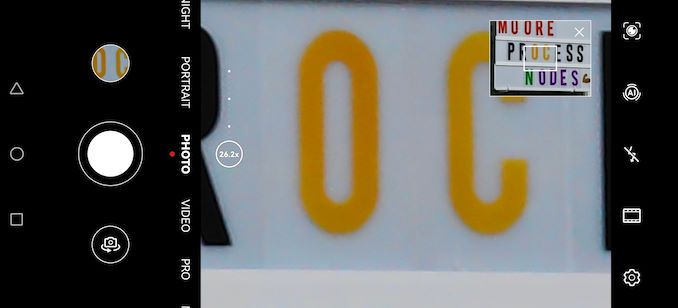
Screenshot showing full sensor image
If I take a screenshot while in this zoomed mode, one good addition at least is that it shows the full wide shot in the top corner, which was always an issue on previous devices of being able to actually find what you wanted to point at. That being said, despite promoting 200x, Huawei is fudging the numbers a bit here – the selectable range is 0.5x (ultrawide) to 100x (upscaled digital zoom).
On top of the cameras, Huawei is promoting its XD Optics and XD Fusion Pro image engine. This is the latest update to the underlying software that combines images from multiple cameras based on a variety of internal algorithms to give you the best image, regardless of which sensor is used, regardless of the lighting and setup, and regardless of the scene. On top of the AI engine, Huawei aims to combine both the best raw data and the best raw post-processing for final images to which the P-series is famous for – some of the best in the industry. While I can’t today put a definitive stake in the ground to say where the P50 Pro sits, the images I have taken have been of a high quality worth posting on our reviews and sharing on social media.
Other camera features on the P50 Pro include dual-view video mode, supporting both front and rear simultaneous recording, now in HD. Huawei now also has its own video editing tool called Petal Clip, aimed to be a simple-to-use editor optimized for the hardware.
As with the previous generations, Huawei has enabled an in-screen fingerprint sensor on the P50 Pro, and it still remains one of the fastest and most accurate I have ever used. This can be used in conjunction with the face unlock feature, which was eerily simple to setup with a single photo.
For the hardware inside our P50, as mentioned we’re running with the Qualcomm Snapdragon S888 edition coming to the UK. This has a total of eight cores: one Arm Cortex-X1 prime core at 2.84 GHz, three Arm Cortex-A78 at 2.42 GHz, and four Arm Cortex-A55 efficiency cores at 1.8 GHz. This is paired with Adreno 660 graphics. What this S888 does not have which some might find interesting is that this is a 4G model. Before Huawei’s link with TSMC was terminated, the leading edge 5G modems from Huawei were either integrated in the Kirin 9000, or were bigger for devices like home access points, and not smartphones. Even then, the S888 has a 5G model, but Huawei has decided not to integrate it, perhaps related to the entity list limitations on Qualcomm selling chips to Huawei, or simply because Huawei couldn’t enable the internal solution for it with what they had access to. But Huawei's Kirin 9000 model of the P50 Pro is also limited to 4G, so that must be an overall design decision.
We have some performance graphs of tests we’ve been able to run. Nothing big and differentiating in this small hands-on, but it’s going to be a bit behind the curve of other flagships when s8g1 and Dimensity 9000 devices come to market. If anything, it means the pricing has to match other one-year flagships.
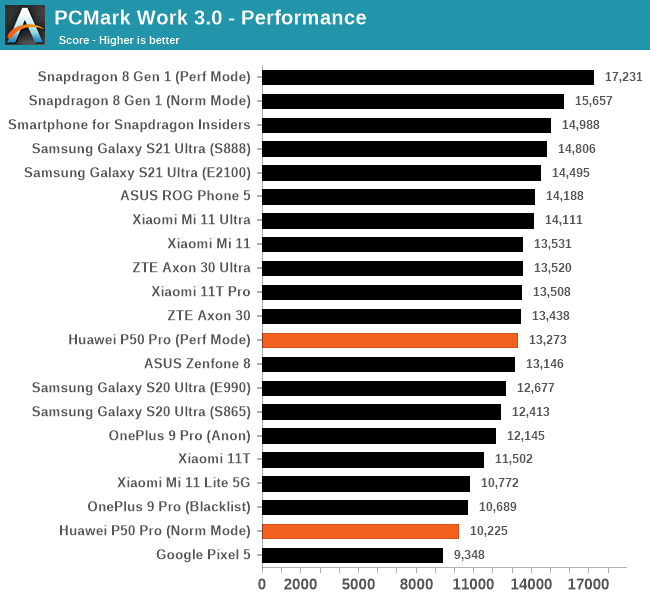
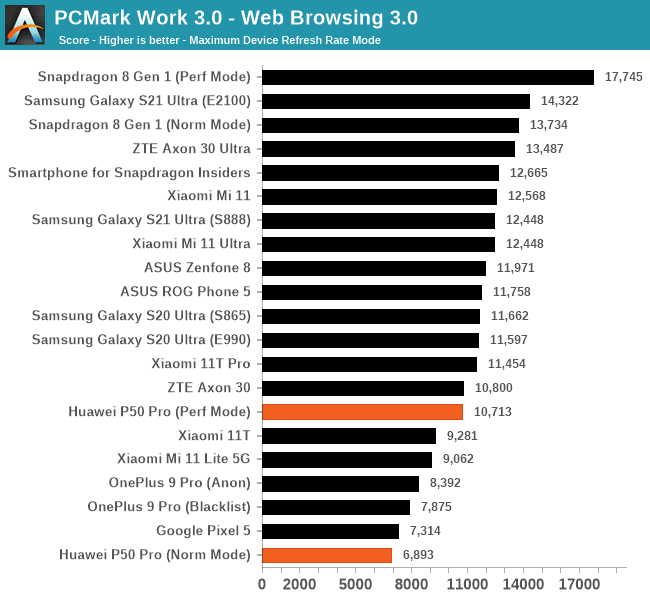
Performance in the few tests we've run was decidedly lacklustre compared to the premium S888 devices we've already tested, even in performance mode. Geekbench 5 was still in the right field for single thread, but down 10% in mutlithread, and PCMark showed a sizeable difference. In idle power, we saw the Normal mode and Performance mode differ by 30%, showcasing that the Performance mode is more akin to a benchmarking mode. It is possible that the metrics here are more indicative of aiming for better efficiency with the SoC, leading to better battery life.
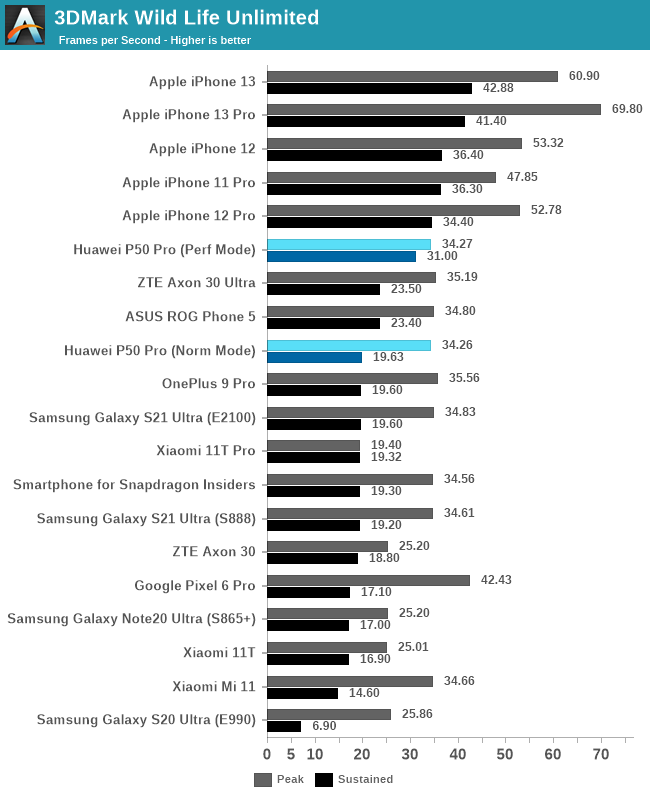
When we look at graphics performance, the P50 Pro scores quite regular against other S888 devices in normal mode, but in performance mode, the GPU is basically cranked to the maximum. This was enough for the device to start showcasing overheating warnings and stop the test - we were only able to complete the test when we strapped a sizeable fan to the phone with a rubber band. This further confirms that the performance mode is moreso for benchmarks and it's really the normal mode numbers that is what are going to be experienced from day to day. It's worth noting that the P50 Pro in Norm mode reduced itself to the sustained values after only two cycles of our test, a couple of minutes each.
Other features on the P50 Pro include models up to 12 GB of LPDDR5 and 512 GB of storage, whereas ours was an 8 GB / 256 GB edition, which might be the highest configuration for the Snapdragon version. Wi-Fi 6 and BT 5.2 are integrated, as well as a USB Type-C 5 Gbps connector for charging. Huawei lists the P50 Pro as IP68 rated, defined as resisting water ingress up to 1.5 meters for up to 30 minutes, which is sometimes missing from flagships as it does cost extra to enable it (and sometimes increases the device size and weight). Despite this, the P50 Pro is 8.5mm thick, and weighs 196g, which is in the ballpark of most other flagships.
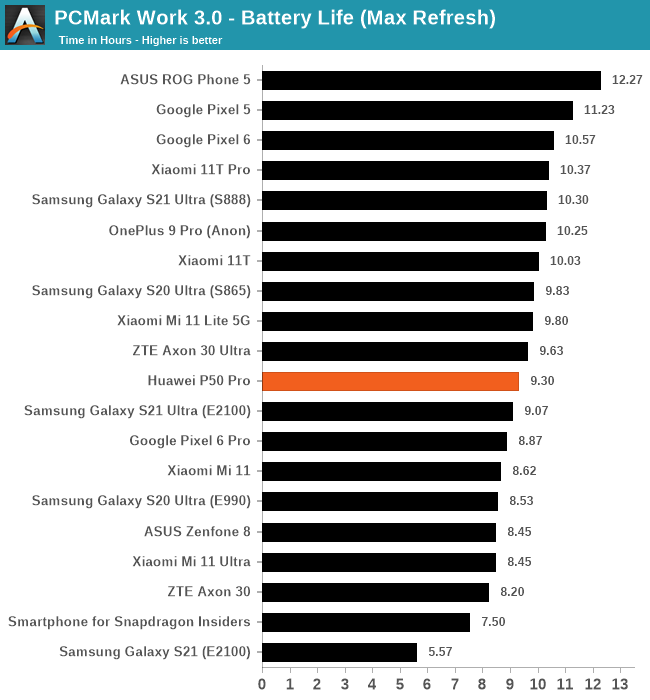
Normal mode battery life, 200 nits
The battery inside is a 4260 mAh lithium-polymer unit, and although Huawei doesn’t explicitly list battery life, we achieved over nine hours at 200 nits using the maximum refresh setting, which puts it in the middle of our other S888 phones. It does support a wired 66 W SuperCharge as well (charger in box) and wireless 50 W SuperCharge, the latter requiring Huawei’s own charger stand sold separately - normally a $130 equivalent price, but for launch is down to $50.
Aside from the Golden Black unit we have in for our brief test, Huawei is also launching Cocoa Gold, Pearl White, and Charm Pink. The Snapdragon S888 4G model of the P50 Pro, with 8 GB DRAM and 256 GB of storage, will retail for 1200 EUR. This puts it around the same price as the Samsung Galaxy S21 Ultra upon launch this time last year or the Xiaomi Mi 11 Ultra, both of which have 5G but it is trading some features such as memory and battery life. They both have Google Services, whereas Huawei does not, which has always been a limiting factor in this stage of Huawei’s story.
| AnandTech | Huawei P50 Pro | ||
| SoC | Qualcomm Snapdragon S888 1 x Cortex-X1 at 2.84 GHz 3 x Cortex-A78 at 2.42 GHz 4 x Cortex-A55 at 1.80 GHz Adreno 660 Graphics 6th Gen AI Engine |
Hisilicon Kirin 9000 1 x Cortex-A77 at 3.13 GHz 3 x Cortex-A77 at 2.56 GHz 4 x Cortex-A55 at 2.05 GHz Mali G78MP24 Dual NPU + microNPU |
|
| DRAM / Storage | 8 GB + 128 GB 8 GB + 256 GB 8 GB + 512 GB 12 GB + 512 GB + proprietary NM Card |
||
| Display | 6.6-inch OLED, 600 nits 2700x1288 (21:10) 120 Hz Refresh Rate 300 Hz Touch 1440 Hz PWM Dimming ? DCI-P3 |
||
| Size | 158.8 x 72.8 x 8.5 mm | ||
| Weight | 195 g | ||
| Battery | 4360 mAh (rated), 4260 mAh (typical) | ||
| Charging | 66 W SuperCharge Wired (in-box), 11V/6A 50 W SuperCharge Wireless |
||
| Rear Cameras |
Main | 50 MP, f/1.8, 23mm, PDAF, Laser AF, OIS, 4-in-1 Fusion | |
| B+W | 40 MP, f/1.6, 23mm, Autofocus, 4-in-1 | ||
| Telephoto | 64 MP, f/3.5, 90mm, PDAF, OIS, 3.5x Optical, 4-in-1 | ||
| Wide | 13 MP, f/2.2, 13mm, 120-degree, Autofocus | ||
| Other | XD Fusion, 1080p960, Leica Optics | ||
| Front Camera | 13 MP, f/2.4, 13mm, 100-degree, Autofocus | ||
| IO | USB Type-C 3.1 | ||
| Wireless (local) | 802.11ax (Wi-Fi 6) and Bluetooth 5.2 | ||
| 4096 QAM, 3.6 Gbps | 1024 QAM, 2.4 Gbps | ||
| Cellular | 4G FDD 1/2/3/4/5/7/8/12/17/18/19/20/26/28/32/66 4G TDD 34/38/39/40/41 |
||
| Geo | GPS (L1 + L5 dual) AGPS GLONASS Beidou (B1l + B1C + B2a) GALILEO (E1 + E5a dual) QZSS (L1 + L5 dual) NavIC |
GPS (L1 + L5 dual) AGPS GLONASS Beidou (B1l+C + B2a+b) GALILEO (E1 + E5a + E5b) QZSS (L1 + L5 dual) NavIC |
|
| Ingress Rating | IP68 | ||
| Dual Sim | Single + NM Card, or Dual (also does Single + NM) | ||
| Launch OS | EMUI 12.0.1 | Harmony OS V2 | |
| Launch Price | 8 GB + 256 GB: 1200€ |
||
It’s unclear how a 1200 EUR device, using last year’s flagship SoC, without 5G, is going to perform, even with all the added extras. If the new upcoming flagships are 1400 EUR and above, the Huawei becomes an interesting purchase comparison point for those that don’t need 5G – if upcoming flagships are still around 1200 EUR, then the Huawei P50 Pro needs to drop in price to be in consideration.
Update: Since this review was written, Samsung launched the S22 series. The 6.8-inch S22 Ultra (at 12 GB / 256 GB) is 1299 EUR, featuring an integrated S-Pen, this year's flagship SoC, as well as new camera features, Google Services, and an IP68 rating. This is going to make the 1200 EUR P50 Pro a hard sell.


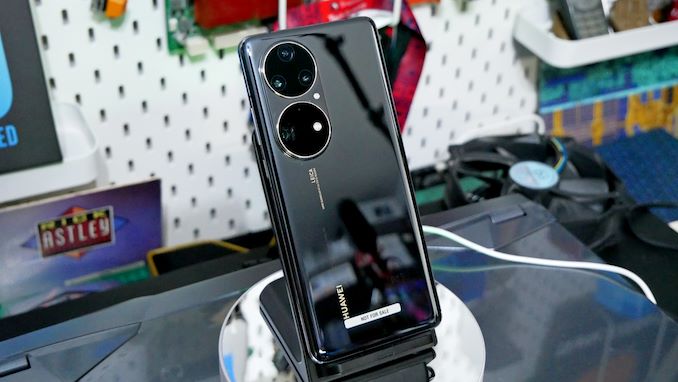
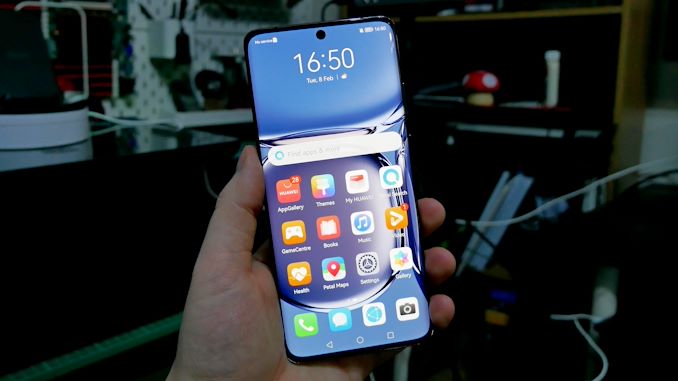

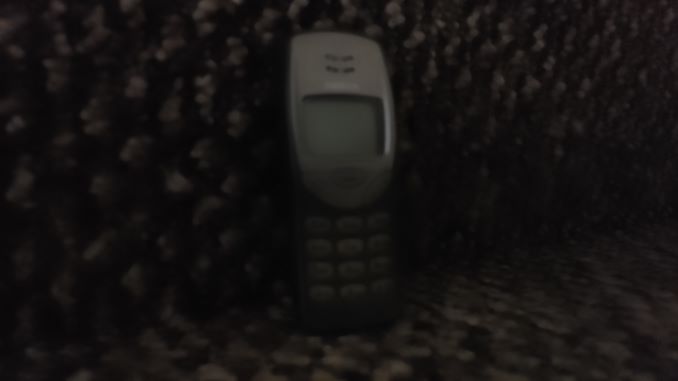
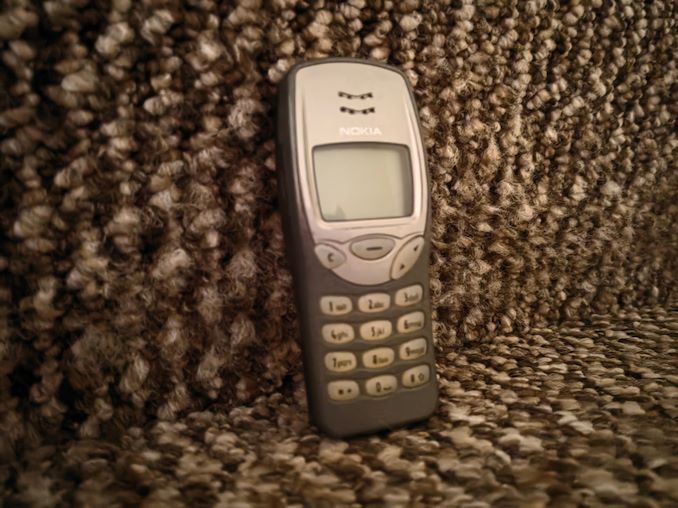
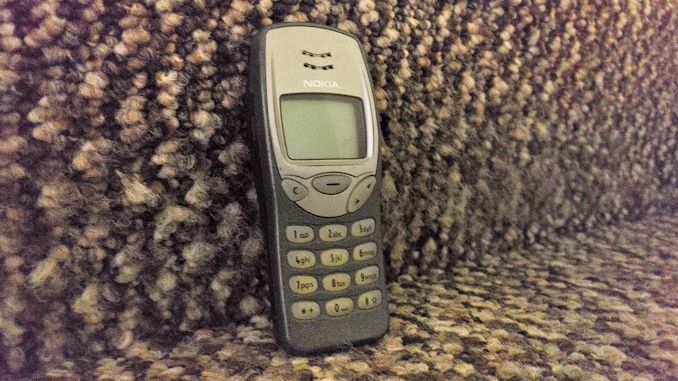
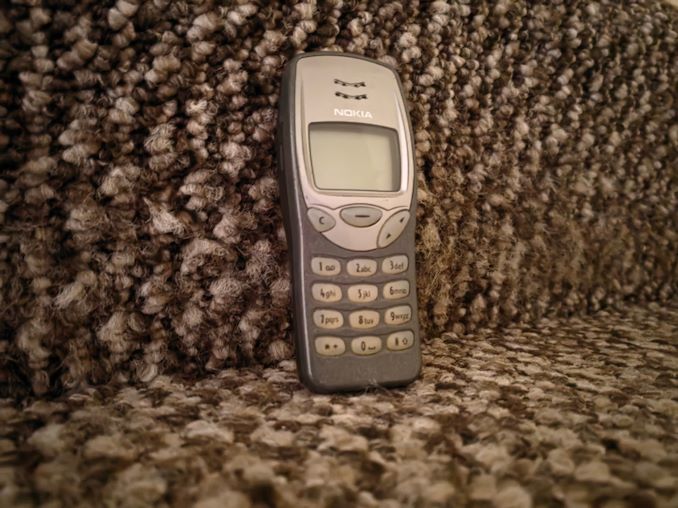
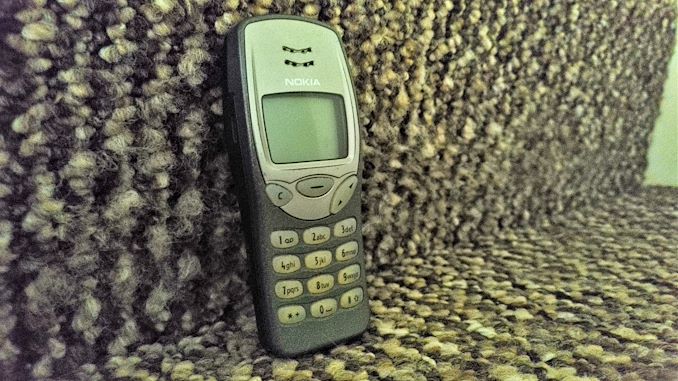

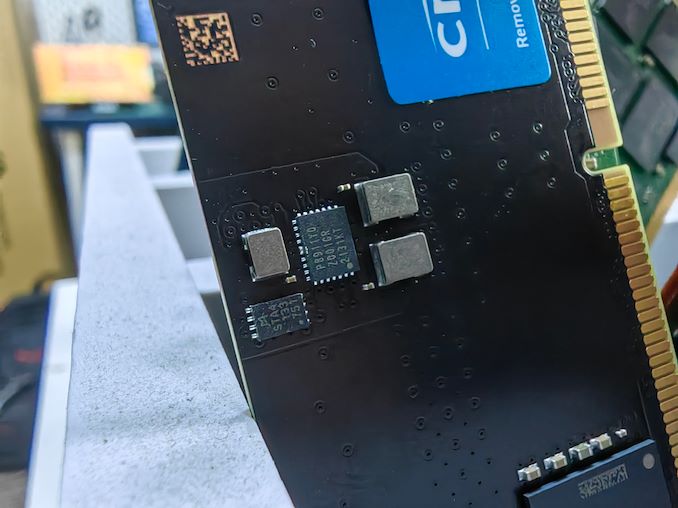










74 Comments
View All Comments
mode_13h - Sunday, February 13, 2022 - link
> Can someone fill me in as to why all these commenters think Huawei is evil?There are three categories of concerns worth examining. I won't go into details because you can easily find information on these, elsewhere. I'm not trying to start/extend a flame war, but rather give you leads you can follow to find relevant details. How you view any of these concerns is subject to interpretation and personal bias, but you can at least see why some are so animated.
The first is the reasons given by the US for placing it on its "Entities" list and why its CFO was detained (in Canada) under indictments by the US.
The next set of concerns arose from the transition to 5G and national security worries about using Chinese equipment in critical telecommunications and networking infrastructure. The situation was complicated by Huawei's equipment assuming an early and dominant position in this market, as well as undercutting potential competitors on price. Some have therefore claimed these concerns are being manufactured or exaggerated, for anti-competitive reasons.
The final category of concerns is the broader set of allegations and concerns over China's industrial & economic policies and their impact. One can include IP issues here, as well.
techgadgetgeek - Wednesday, February 16, 2022 - link
Facts are the US was unable to backup its claims against Huawei. Huawei and China asked the US many times to backup their claims and show evidence but until today have not been able to do so.amosbatto - Friday, March 11, 2022 - link
Huawei does have ties with the Chinese government and does a lot of work for the Chinese military, so there are fears that its networking equipment is used to spy for the Chinese government, but reports of spying are based on unproven allegations. Some people also have fears about their phones for the same reasons (although I personally think those fears are unfounded).For me, the reason to avoid Huawei phones include: 1) Since June 2018, Huawei has locked the bootloader on all their phones, which means that I can't install the OS of my choice, which is LineageOS, 2) Huawei uses a lot of their own custom chips (before the US banned Western fabs from making their chips) and releases no public documentation on them, so the hardware is a black box, and there is no hope that the community can create free drivers, 3) Huawei doesn't have a particularly good record of providing updates for its phones--Google, OnePlus, Galaxy S/Z/Note and Android One devices provide more years of support, 4) Huawei's app store doesn't have all the apps of the Google Play Store.
Chinese workers don't have the right to form independent labor unions, and I hate the surveillance state that China has become, but most phones being sold in Europe and N. America today are assembled in China. If you buy a phone from HMD/Nokia, Lenovo/Motorola, Xiaomi, Vivo, Redmi, OnePlus, Huawei, TCL/Alcatel or GTE, then your phone was probably designed in China as well. The only way to avoid China today, is to buy a high-end Galaxy (S/Z/Note and some A-series) which are assembled in S. Korea and Taiwan. Most Samsung phones are assembled in Vietnam, but 20% are outsourced to Chinese ODMs.
tamemeee - Sunday, February 13, 2022 - link
As a Velvet owner I like this camera comparison haha. Good to see that there is room for improvement always.eastcoast_pete - Sunday, February 13, 2022 - link
Isn't the graph with the GPU performance data misleading? If the sustained 31 fps were only possible under these conditions " - we were only able to complete the test when we strapped a sizeable fan to the phone", then this should be entered as "failed" or "did not complete". As shown, the graph suggests performance that the phone is not able to deliver in everyday situations. I rarely if ever carry a "sizeable fan" with me, and on the rare occasions I did, I was transporting a plug-in fan in its box from one location to another, and I didn't have a battery UPS strapped to my back to operate said fan.mode_13h - Monday, February 14, 2022 - link
Agreed. There should've been an asterisk next to that label of the graph, with the footnote either saying "with fan" or referring the reader to the article text.Hopefully, these perf mode values won't be propagated to another phone review, where this context is missing.
ksec - Monday, February 14, 2022 - link
At this point in time I wonder if it make sense to review "Smartphone" in terms of hardware. Since we are not testing Wireless Radio Performance They only differ in Camera and SoC. SoC is basically either Qualcomm or MediaTek + the Smartphone's heat dissertation design. Which leaves Camera being the biggest differentiation.s.yu - Friday, February 25, 2022 - link
And from the few samples I don't believe Huawei's improved these couple years, they seem to have recycled the same sensor(or perhaps with minor tweaks) for years now leaving room for continued tuning, yet the smearing doesn't seem any better, the sample against the sun is especially bad, I believe some years-old Gcam version on a relatively recent generic sensor >1/1.5" could get a far cleaner shot. I'd almost say that they're just content with the waxy look but IIRC some Mate samples have been better than this.c4v3man - Tuesday, February 15, 2022 - link
First off, thanks for the review. In the USA anyways, it's hard to find information about Huawei. There's no chance I'd purchase one, given both it's difficulty to acquire here in the US, as well as given it's eccentricities, but it's nice to see how Chinese designed phones are competing. Given the pricing they're asking, it seems like a no go based on the poor camera quality and lack of 5G. Honestly I'm surprised the performance and battery life are close to the S21U (snapdragon). I'd be more interested if the Kirin chips were meeting/beating snapdragon in general performance and performance/watt.Keep it up!
Sattamatkamatka - Tuesday, February 22, 2022 - link
Thanks for the useful informationhttps://sattamatka143.com/main-bazar-panel-chart-म...ाजार-पैनल-चार्ट
https://sattamatka143.com/sridevi-panel-chart-श्रीदेवी-पैनल-चार्ट